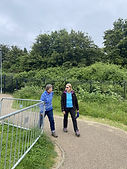History of the site
Walthamstow Marshed is an area of wetland bordering the River Lea and nestled between Hackney and Waltham Forest. It’s one of the last remaining examples of London’s once vast and widespread floodplain grasslands. From Saxon times until well into the 20th century the marsh was used as “Lammas land”, a place for local people to cut hay and graze their livestock.
In 1909, the pioneer, Sir Edwin Alliott Verdon Roe became the first Englishman to fly an all-British made triplane (The Yellow Terror) on Walthamstow Marshes. A blue plaque commemorating his efforts is located at the western end of the viaduct where he built his machine.
During the industrial revolution, the land retained its agricultural use, though increasingly hemmed in by surrounding developments. The impact of aggressive industrial urbanisation pressured local agricultural communities into relinquishing the ancient traditions of hay making and grazing. As a consequence the local council acquired the site with plans to develop it for recreational use, proposals which were hindered by the onset of World War II and the resulting period of austerity. WWII left its scars on the landscape across the Lee Valley, signs of anti-landing trenches and the impacts from shelling are still visible today.
Present day
Walthamstow Marshes’ today serves a number of functions on a local, national and even international scale.
Primarily it is a place to enjoy over 400 plant and animal species that use the site across the year. Located on the edge of London, sandwiched between zones 2 & 3 on the London underground, Walthamstow Marshes provides a huge number of people with the opportunity to feel at the heart of the countryside in the middle of the city.
It has become a hugely important connective piece of the landscape which welcomes over a million visitors a year.
Bordered on its southern edge is the brand new Lee Valley Ice Centre, a world class and sensitively designed venue which features fabulous wildlife friendly landscaping, green walls and the installation of two large ponds. North of the reserve sits the hugely important Walthamstow Wetlands managed by the London Wildlife Trust, home to a diverse communities of wetland birds, many of which use the Marshes as hunting and feeding grounds.









.png)


.jpg)

%20(1).jpg)













.avif)
.jpg)
.jpg)